Some old guy’s map case
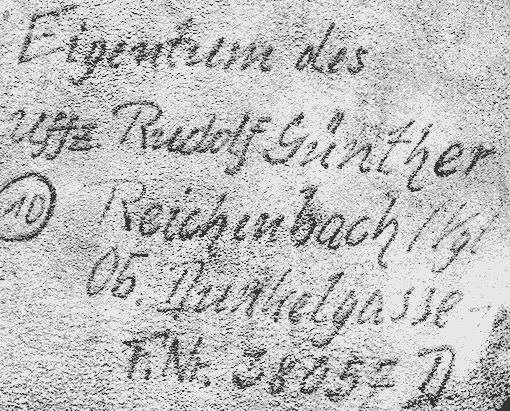
Okay, that’s the inscription inside the top flap of my new German WWII leather mapcase. It’s in blue pen — it looks like ballpoint, but probably isn’t, as someone once told me a long story about how expensive and desirable biro pens were during the War. I make it as follows:
Eigentum des
Uffz. Rudolf Günther
Reichenbach iVgt
Ob. Dunkelgasse
F.Nr 38054 D
And my guess at a translation, based on scootching around Google:
Property of
Unteroffizier Rudolf Günther
Reichenbach im Vogtland
Obere Dunkelgasse
apartment number?
An Unteroffizier is an under-officer, or NCO. There is an Obere Dunkelgasse in Reichenbach im Vogtland (the streetname means “Upper Dark Alley”).
Now, here’s a thing: I get several hits for “Unteroffizier Rudolf Günther”. It seems there’s a 1990 reproduction of a 1900 German military passport in that name floating around (here’s an old German eBay listing, for example).
So, did my intrepid German friend (or someone else) write that name on the bag with a ballpoint to make it more desirable? There were half a dozen there. He didn’t point it out to me and it was no more expensive than the others with no inscription, even though mine is better leather (he said the others were toward the end of the war when the Germans were stretched thin, and he showed me the date letters on several of the bags).
Or is this a commonish German name? Is it weird that he wrote a home address on it, or is that a home address? All very puzzling.
What? Oh, sure…I’ll take a picture of the outside of the bag later. I’m kind of behind on my chores tonight….
Posted: August 22nd, 2017 under personal.
Comments: 25
Comments
Comment from Crabby Old Bat
Time: August 22, 2017, 8:46 pm
That “4” in 38054 looks like a German “7” to me. iVgt could be an abbreviation for “im Vogtland,” although it looks like the “i” could be a slash: Reichenbach /Vgt, an abbreviation for Reichenbach / Vogtland. Don’t know what the circled 10 is for.
Comment from p2
Time: August 22, 2017, 8:59 pm
that is a 7…. and i’d wager the name is pretty common. i knew several people with that surname while stationed in germany. rudolf is real common. the f number may be a serial or service number…. usually a flat or house number is after the street name in german addresses. mune was am petzenberg 26.
Comment from Durnedyankee
Time: August 22, 2017, 9:05 pm
Maybe he knew it would be more reliable to have it returned to a fixed address than to assume someone returning it would ship it to the right place in the Army (where it might not make it’s wayward way home ever). Not like they had a directory listing of where everyone was for you to send it back to them in whatever far flung corner of the Reich they might be on any given day.
Or maybe he hoped it would be sent ‘home’ after they’d laid him to his final rest on the wrong side of the grass one afternoon. His army issue s*it stays with the army for the next happy warrior to use, his arguably personal stuff goes home, and he’d have no way of knowing if the guys who recovered it might know him, so…
Comment from Sigivald
Time: August 22, 2017, 9:16 pm
It’s a pretty common sort of generic German name.
And the style of handwriting is Absolutely Correct (if I remember the style of the day correctly) for the era, so either authentic or someone who took some effort faking it.
Comment from Deborah HH
Time: August 22, 2017, 9:49 pm
Re: ink. It’s possible that Rudolf Günther wrote in his map case long after the war, which could account for his home address and the use of—what looks like to me—a ball point pen. Do you have a linen tester or a printer’s loupe? Ball point ink would sit on the surface of the rough leather and ink from a fountain pen would most likely look a little soaked in.
Comment from Ric Fan
Time: August 23, 2017, 3:18 am
Again, ask at Axis History Forum. They know quite a bit about this stuff. Most are history buffs, many Germans, and plenty of collectors who also would be greatly knowledgeable.
I signed up for a cartography class in college but dropped out after the first class for reasons I forgot. I took an archaeological surveying course and froze my ass off. I always wanted to take a calligrapher’s map making class bc the maps look so neat. Hopefully, one day…
Comment from Ric Fan
Time: August 23, 2017, 3:22 am
TBF, the writing looks too modern and the ink shd be more faded, no?
Comment from S. Weasel
Time: August 23, 2017, 8:45 am
The writing is pretty faded, Ric Fan. I pumped up the contrast and saved it as a 4-color .gif to try to make it more legible.
Comment from Deborah HH
Time: August 23, 2017, 2:46 pm
@Ric Fan: My son is a professional cartographer and it’s all done by computers now. Not a calligrapher to be found anywhere.
I was probably one of the last of the old-fashioned cartographic drafters, bridging the gap with hand-lettering and Leroy lettering, to computer-generated mapping. For a few years I worked for an engineer who designed post-tensioned concrete parking garages and he wanted the drawings lettered in architectural lettering (which I thought was a bit fussy for concrete construction). I did learn calligraphy, but I never used it on maps.
Comment from dustoffmom
Time: August 23, 2017, 4:29 pm
Spent 7-8 yrs living there, on the economy as they say, and quickly learned to make my numbers like they do. That is definitly a German 7, with the cross hatch on the ‘stem’. A German 1 looks mostly like an English 7, with no cross hatch. After having my 7’s recorded as 1’s a few times I learned to write them as they do. And still cross hatch my 7’s to this day.
Comment from Ric Fan
Time: August 23, 2017, 4:40 pm
Deborah: There’s a difference between cartographers doing calligraphy and calligraphers doing (simple) cartography. I know calligraphers can do a map to the venue when they are doing wedding invitations. There are also fantasy maps. I’ve seen them do it for the SCA. My favorite calligraphy map was one someone did of their backyard. It had miniature portraits of their cats over the years on the border and the map noted their favorite spots: Fluffy loved laying under this lilac bush on summer afternoons, etc. It was very nice. A few years ago, I saw a class offered in calligraphy maps but didnt have the time.
Comment from Ric Fan
Time: August 23, 2017, 4:47 pm
I cross my 7s and 1s but that is a throw back to my college surveying days. I would categorize this handwriting style as italic. The germans back then had a weird style with a few weird letters thrown in. This handwriting is exceptionally legible. Then again, if he was a professional draftsman, maybe he was taught to write like that. Should look up some old WW2 kraut maps and see what they look like.
Comment from Formerly known as Skeptic
Time: August 23, 2017, 5:34 pm
Got it.
The “F.Nr 38057 D” appears to refer to his Field Post (Feldpost) number which is the military mailing address for his unit (https://en.wikipedia.org/wiki/Feldpost).
According to this site:
http://www.axishistory.com/axis-nations/383-germany-military-other/feldpost/8963-feldpost-numbers-38000-38999
his unit was (depending on the date):
38057
(Mobilmachung-1.1.1940) Stab III Infanterie-Regiment 472
(28.4.1940-19.9.1940) Stab III u. 9.-12. Kompanie
Infanterie-Regiment 472
(12.3.1943-7.9.1943) Stab I u. 1.-4. Kompanie Grenadier-Regiment 7.
Per the Wikipedia entry, The “D” would denote his company within the regiment.
Oh, and if the Field Post Number is on it, that would seem to indicate that the markings are indeed contemporaneous with its wartime usage.
Comment from Formerly known as Skeptic
Time: August 23, 2017, 5:47 pm
The 472nd appears to have been part of the 252. Infanterie-Division – History here:
http://www.axishistory.com/axis-nations/germany-a-austria/heer/150-germany-heer/heer-divisionen/3593-252-infanterie-division
Comment from Ric Fan
Time: August 23, 2017, 6:14 pm
Area of operations
Poland (Sep 1939 – Nov 1939)
West Wall (Nov 1939 – July 1940)
Poland (July 1940 – June 1941)
Eastern front, central sector (June 1941 – Dec 1944)
Poland (Dec 1944 – May 1945)
Yikes! Not good at all:
https://en.wikipedia.org/wiki/Eastern_Front_(World_War_II)
Comment from Deborah HH
Time: August 23, 2017, 6:17 pm
@Ric Fan. I was thinking of cartography as the science not cartography as the art. Yes—I love all those things you described. And I agree that Rudolf’s printing indicates training.
Comment from Formerly known as Skeptic
Time: August 23, 2017, 6:45 pm
Yeah Ric Fan, and it looks like the the 472nd was disbanded in Jan/Feb 1943 (reformed in 1944), I would guess due to losses.
Comment from Durnedyankee
Time: August 23, 2017, 7:00 pm
@Ric Fan
Yea, there’s really no good place to be on the Eastern Front after Kursk except ‘leaving’.
It continues to amaze me they stemmed the back flow out of Russia for as long as they did.
Comment from S. Weasel
Time: August 23, 2017, 7:34 pm
Ah-ha! I knew you guys would get your teeth into it eventually. Thanks for the info.
Deborah, I know someone here who worked for the Ordnance Survey during the metricization (sp?) in the Seventies. Her specialty was freehanding those little clumps of marsh grass. A surprising amount on OS Survey maps were freehanded.
I was never allowed to use the Leroy. I’m sure we’ve had this conversation 🙁
Comment from Durnedyankee
Time: August 23, 2017, 9:36 pm
Course, they could have NOT invaded Eastern Europe at all and then they wouldn’t have needed so many map cases for their NCOs.
Comment from Deborah HH
Time: August 23, 2017, 10:08 pm
Stoaty, you should look for a Leroy set on eBay. Very cheap—$25 and under here. Wooden boxes. It’s not too late for you to have some fun. I paid $207 for my set in August 1977.
Comment from S. Weasel
Time: August 23, 2017, 10:34 pm
Whaddya know. You’re right, Deborah. I don’t have a drafting arm any more, though.
Comment from Deborah HH
Time: August 23, 2017, 11:07 pm
Nah—you don’t need a drafting arm for lettering. I always used a 12″ 30-60-90 triangle with the small guides, and a 14″ for the longer ones. Quick and fast. A drafting arm would take too long to maneuver.
Comment from Ric Fan
Time: August 24, 2017, 2:31 am
Might as well learn calligraphy. I was never great at it but after studying italic, my teacher introduced me to Roman and informal tiny Roman caps which is used for lettering. Oddly, I found the tiny Roman letters really enjoyable to do.
Comment from Durnedyankee
Time: August 24, 2017, 12:14 pm
Leeeeeeeeeerooooooooooooy Jenkins?
And you even have chicken.

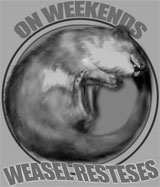


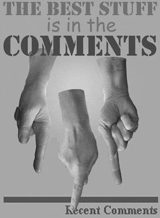

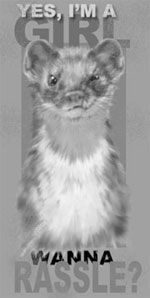
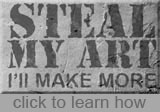



Write a comment
Beware: more than one link in a comment is apt to earn you a trip to the spam filter, where you will remain -- cold, frightened and alone -- until I remember to clean the trap. But, hey, without Akismet, we'd be up to our asses in...well, ass porn, mostly.<< carry me back to ol' virginny